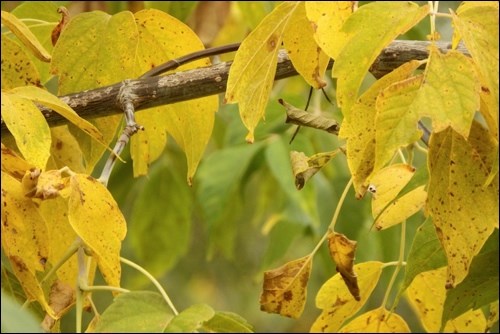There are a few factors that influence leaves to change colour in the fall. The growth habit of trees, length of available daylight, colour, pigments in the leaves, leaf types and the influence of weather as summer ends and fall begins all play a part.
On the prairies, warm summers with rainfall change to a cool, cold season when trees will not grow. Fall colour occurs in the transition period between the warm weather and the cold weather. So you want me to tell you something you don’t know right?
The changing colour that is seen is a result in a change in the pigments within the leaf and what light waves are being absorbed versus the ones that are being reflected. Hmmmmmmmmmmm?
The four pigments that are known to cause colour in tree leaves include chlorophylls (green), carotenoids (yellow), anthocyanins (reds) and tannins (browns). As summer moves to fall and growth conditions (day length and cooler temperatures) are less favourable to producing chlorophyll, which is the green colour of leaves, the green begins to fade and change to yellow. This is the carotenoid (the same pigment that colours carrots orange) starting to be in larger concentrations than the chlorophyll. Good to know right? Bored? But wait, I haven’t got to the anthocyanin part yet.
Short days and cool temperatures trigger the leaves into the ripening process that triggers colour change.
At the same time, the point at which the leaf attaches to the twig becomes sealed and brittle and wind and the weight of the leaf itself, seals its final fate. It falls. You rake.
The anthocyanins (reds, pinks, purples) develop before the leaf totally falls off but at a time when the leaf attachment is becoming brittle and no longer allows tree sugars through but traps them in the leaf. Good growing conditions can deepen the red colour. Some of our best fall reds can be seen in amur maples.
The tannins are just brown and not really exciting to talk about, especially when compared to talking about the anthocyanins . I know, I know, stay calm. Impress your friends with words they never heard of. Use them often.
Weather conditions can influence the intensity of colour. Warm bright fall days and cool nights (not freezing) seem to intensify and prolong fall colour. If we are plagued with grey rainy days at this time, colour intensity is reduced and the length of a colourful fall is shortened. If there are insect pests or disease in the trees, this not only shortens the fall colour show, it can eliminate the show all together.
This happened again this year to the Balsam poplars in the river valley. They packed it in early with no show of colour to speak of due to a leaf disease Here we go. Here comes our nine months of winter and three months of tough sleddin’. Don’t blink, you don’t want to miss fall on the prairies.



